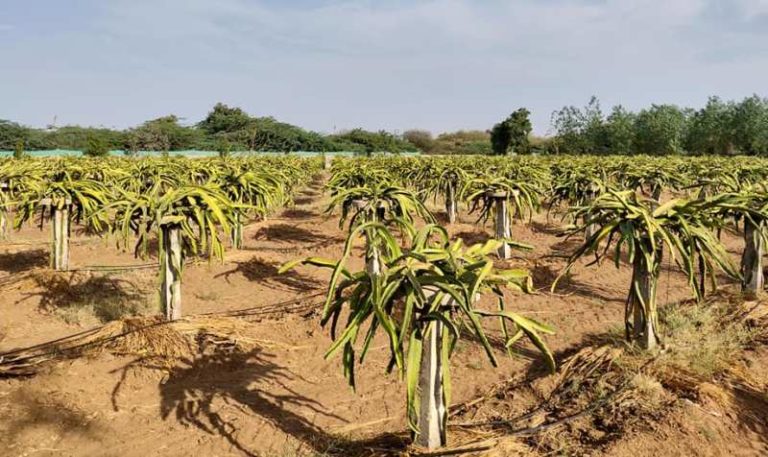In the ever-evolving landscape of agriculture, dragon fruit farming is more profitable, not only for its exotic appeal but also for its potential profitability. As farmers seek diversification and higher returns on investment, the allure of cultivating dragon fruit has become increasingly enticing. But the question looms: is dragon fruit farming more profitable than traditional crops? Let’s delve into the intricacies of dragon fruit farming to uncover its economic viability and potential for profitability.
Table of Contents

Understanding Dragon Fruit Farming is more profitable
Dragon fruit, also known as pitaya, is a tropical fruit native to Central and South America but cultivated in various parts of the world. It thrives in warm climates with well-drained soil and ample sunlight, making it suitable for cultivation in regions like Southeast Asia, Australia, and parts of the United States. The fruit’s unique appearance, vibrant colors, and nutritional benefits have fueled its popularity among consumers, leading to increased demand in both local and international markets.

Factors Influencing Profitability
Several factors influence the profitability of dragon fruit farming:
- Market Demand: The demand for dragon fruit has been steadily rising due to its perceived health benefits and culinary versatility. With consumers increasingly seeking exotic fruits and healthy alternatives, dragon fruit has carved a niche for itself in the global market. However, market demand can vary depending on factors such as location, seasonality, and consumer preferences.
- Yield and Productivity: The yield potential of dragon fruit varies depending on factors such as soil quality, climate, cultivation practices, and plant variety. While mature dragon fruit plants can yield abundant fruit, establishing and nurturing the plants to maturity requires time, effort, and investment. Additionally, factors such as pests, diseases, and environmental stressors can affect productivity and overall yield.
- Input Costs: Like any agricultural endeavour, dragon fruit farming entails various input costs, including land acquisition or lease, plant material, irrigation, fertilizers, pest control measures, labour, and infrastructure. The initial investment required to establish a dragon fruit orchard can be substantial, particularly in regions where land prices are high or infrastructure development is needed.
- Market Prices: The profitability of dragon fruit farming is closely tied to market prices, which can fluctuate based on supply and demand dynamics, seasonality, competition, and quality standards. While dragon fruit prices have generally trended upwards in recent years, farmers may face price volatility and competition from other producers.

Comparative Analysis
To ascertain whether dragon fruit farming is indeed more profitable than traditional crops, a comparative analysis is warranted:
- Profitability Potential: While dragon fruit commands higher prices compared to some conventional fruits, such as bananas or oranges, its profitability hinges on various factors, including yield per hectare, input costs, market prices, and production efficiency. In regions where dragon fruit thrives and fetches premium prices, it can indeed be more profitable than certain traditional crops.
- Market Access and Competition: Market access and competition have an impact on the profitability of dragon fruit farming. In areas with established dragon fruit markets and limited competition, farmers may enjoy higher profits. However, in regions where dragon fruit faces stiff competition from other producers or encounters barriers to market access, profitability may be more challenging to achieve.
- Risk and Uncertainty: Like any agricultural enterprise, dragon fruit farming entails inherent risks and uncertainties, including weather-related hazards, pest and disease outbreaks, market fluctuations, and regulatory changes. Managing these risks requires careful planning, risk mitigation strategies, and adaptability.
- Long-term Investment: Dragon fruit farming is often viewed as a long-term investment, as it can take several years for newly planted orchards to reach full production capacity. While initial returns may be modest, the potential for profitability increases as dragon fruit plants mature and yield higher quantities of fruit.
Conclusion
In conclusion, the question of whether dragon fruit farming is more profitable than traditional crops is multifaceted and contingent on various factors. While dragon fruit offers promising opportunities for higher returns due to its market demand, premium prices, and nutritional value, profitability hinges on factors such as yield, input costs, market dynamics, competition, and risk management. Ultimately, successful dragon fruit farming requires careful planning, diligent management, and a thorough understanding of market forces and agricultural practices. While the potential for profitability exists, farmers must weigh the benefits and challenges of dragon fruit farming against their circumstances and objectives.
